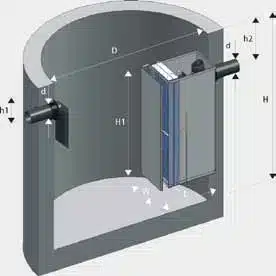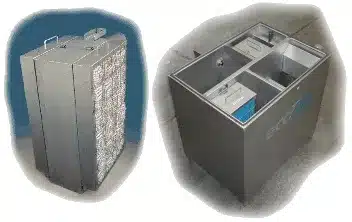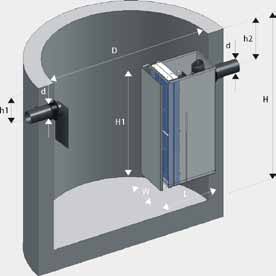In California, water is a precious resource. California Below Ground OWS are key to keeping our groundwater safe. They work hard to stop harmful substances from getting into our water.
OWS are crucial for places that release wastewater with oil or dirt. This includes quick-lube stations and car repair shops. They make sure our water supply stays clean by keeping out dangerous materials. Thanks to tough environmental laws, these systems are a must for many businesses.
OWS systems come in different sizes, handling from 50 to 5,000 gallons per minute. This flexibility helps with managing wastewater in various industries. By keeping oil and water apart, these systems protect our underground water.
Key Takeaways
- Freytech Inc. Below Ground OWS are essential for protecting California’s groundwater
- These systems are required in various industrial settings
- Capacities range from 50 to 5,000 gallons per minute
- California’s environmental regulations necessitate the use of OWS
- Effective oil-water separation contributes to groundwater sustainability
Understanding Below Ground Oil Water Separators in California
Below Ground OWS are key in California’s industrial and commercial scenes. They keep oil and water apart, protecting the environment and following strict rules. Let’s look into what makes these devices so important.
Definition and Purpose of Below Ground OWS
These systems work at the same pressure as the air around us. They have special parts like inlets, outlets, and manways for better use. Their main job is to keep oil and water apart in industrial settings, protecting our water and reducing harm to the environment.
Regulatory Requirements in California
California has tough rules for Below Ground OWS. These systems must meet the Underwriter’s Laboratories UL-SU2215 standard. Before they’re sent out, they’re checked for leaks to make sure they work well and last long.
Benefits of Below Ground Systems
Below Ground OWS bring many benefits. They make oil separation efficient, helping companies follow environmental laws. They protect our groundwater, which is very important in California. Plus, they help with monitoring groundwater and land subsidence, which is a big issue in some areas.
Design and Construction of California Below Ground OWS
California’s Below Ground Oil Water Separators are made to high standards. They help prevent well interference and manage overdraft. The design is all about being tough, efficient, and following state rules.
Material Selection: Carbon Steel and Coating Options
Carbon steel is the main material used for these separators. It’s strong and lasts a long time. To protect it from rust, we use coatings like industrial-grade epoxy and FRP.
These coatings help the separator stay strong in tough underground conditions.
Capacity Range: 50 to 5,000 Gallons Per Minute
There are different sizes of separators for various needs. They can handle from 50 to 5,000 gallons of water per minute. This means they can manage lots of water and help with compaction monitoring.
They come in single and double wall types to fit different places.
UL-SU2215 Certification and Other Standards
Quality and safety are key. The separators meet UL-58 and UL-1746 standards. They also have a UL-SU2215 certification for the best performance.
There are more protection options like sti-P3 and Act-100 against corrosion. These standards make sure the separators work well in California’s different soils.
Key Components and Features of Below Ground OWS
California Below Ground OWS systems have key parts to efficiently separate oil from water. The inlet and outlet are where the wastewater comes in and goes out. A flow distributor spreads the water evenly, and an energy dissipater device helps reduce turbulence.
The presettling chamber lets solids settle, and the sludge baffle keeps them from getting back up. The oil coalescing chamber has special plates and devices to help separate oil from water.
An oil dam and pipes move the clean water to the effluent clearwell. Access covers make it easy to check and maintain each chamber. These parts help the system get rid of 5 PPM of oil, with some models even reaching 0.1 PPM.
The design of California Below Ground OWS considers water levels and how it affects groundwater. This makes sure the system works well and doesn’t harm the environment. It also helps with managing water resources for the long term.
California Below Ground OWS: Installation and Maintenance
Installing a Below Ground OWS in California needs careful planning and following local rules. Getting the site ready is key for the system to work well and last long. We’ll look into the main parts of putting it in, keeping it running, and fixing any problems.
Site Preparation and Underground Installation Process
The first step in installing a Below Ground OWS is checking the site carefully. This means digging, watching the groundwater, and checking how stable the soil is. Then, the separator is put into the site, making sure it’s vented right and easy to get to for upkeep.
Routine Maintenance and Inspection Requirements
Keeping a Below Ground OWS in good shape is important. This means checking it often, cleaning it, and watching the oil and dirt levels. Watching the groundwater around it helps spot leaks or harm to the environment. Following a strict upkeep plan helps meet California’s tough environmental laws.
These separators are crucial in storm water systems. They process runoff to meet the US EPA’s Clean Water Act standards. With effective oily water treatment, facilities protect the environment and dodge big fines.
Troubleshooting Common Issues
Even with regular care, systems can run into problems. Issues like not separating well, bad smells, or seeing oil in the water are common. Finding and fixing these problems fast is key. Companies like Freytech Inc. offer help with fixing these issues and offer long warranties against rust, making sure Below Ground OWS systems in California work well for a long time.










